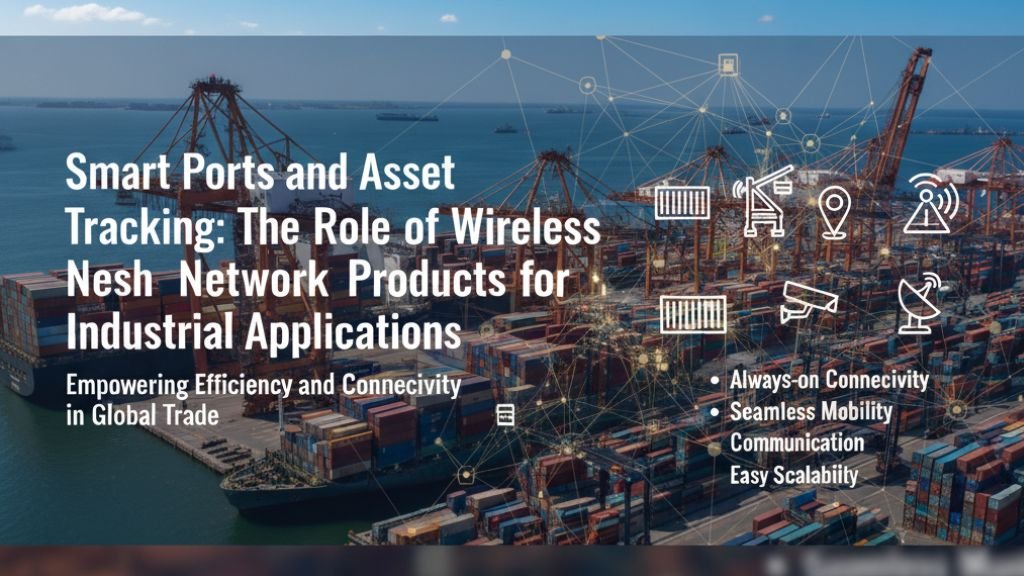The shipping and logistics industry is the backbone of global trade, and ports are at the heart of this ecosystem. Every day, thousands of containers, vehicles, and cargo units move in and out of modern ports, creating a highly complex operational environment. Managing such vast operations requires real-time connectivity, reliable surveillance, and seamless asset tracking systems. This is where Wireless Mesh network products for Industrial Applications are transforming port operations.
Challenges in Port Operations
Ports face unique challenges when it comes to connectivity:
-
High mobility: Trucks, cranes, and ships are constantly on the move.
-
Large area coverage: Ports often stretch across hundreds of acres.
-
Harsh environments: Extreme weather, saltwater exposure, and interference from heavy machinery make networking difficult.
-
Security needs: Monitoring sensitive cargo and preventing theft or smuggling requires robust video surveillance and data communication.
Traditional wired or point-to-point networks often struggle to provide flexible, scalable solutions in such environments.
How Wireless Mesh Networks Solve the Problem
Wireless mesh technology provides an adaptive and scalable networking solution for ports. Unlike traditional networks that rely on centralized hubs, mesh networks distribute connectivity across multiple nodes. This ensures:
-
Always-on connectivity: If one node fails, data automatically reroutes through another.
-
Seamless mobility: Vehicles and equipment remain connected as they move across large areas.
-
High-bandwidth communication: Supports video surveillance, asset tracking, and IoT devices simultaneously.
-
Easy scalability: New nodes can be added as port operations expand.
For example, mesh-enabled surveillance cameras can be deployed across terminals, container yards, and entry points to monitor operations 24/7 without the need for complex cabling.
Asset Tracking and Operational Efficiency
One of the biggest advantages of deploying Wireless Mesh network products for Industrial Applications in ports is improved asset tracking. Containers fitted with RFID or IoT sensors can communicate seamlessly with mesh nodes, providing real-time location data. This allows port authorities to:
-
Prevent misplaced or stolen cargo
-
Optimize container movement and storage
-
Reduce downtime and manual tracking errors
-
Improve safety and operational efficiency
The result is faster turnaround times for ships, better coordination among port staff, and increased profitability.
Future-Ready Smart Ports
As ports move toward becoming “smart ports,” mesh networks will play a critical role in supporting automation, AI-driven logistics, and real-time analytics. From autonomous cranes to AI-powered surveillance, wireless mesh connectivity ensures that all systems remain connected, secure, and efficient.
By investing in Wireless Mesh network products for Industrial Applications, ports are not only solving today’s connectivity challenges but also preparing for future demands in global trade and logistics.
Conclusion
Ports worldwide are embracing digital transformation, and wireless mesh technology is leading the way. With reliable, scalable, and cost-effective networking, ports can improve asset tracking, enhance security, and streamline operations. As industries push toward automation and smarter infrastructure, wireless mesh solutions will remain a vital enabler of efficiency and growth.
1. What are Wireless Mesh network products for Industrial Applications?
Wireless Mesh network products for Industrial Applications are advanced connectivity solutions designed to provide reliable, high-speed communication across large and complex environments such as ports, factories, and oil & gas facilities. They enable real-time data transfer, video surveillance, and asset tracking with minimal downtime.
2. Why are mesh networks better than traditional wired solutions in ports?
Unlike traditional wired networks, mesh networks don’t rely on a single point of failure. They offer self-healing capabilities, mobility support for moving vehicles and equipment, and easy scalability, making them ideal for challenging port environments.
3. How do Wireless Mesh network products for Industrial Applications improve asset tracking?
By integrating IoT sensors and RFID tags with mesh nodes, ports can monitor container movement in real time. This reduces delays, prevents losses, and ensures better security, ultimately improving operational efficiency and profitability.
